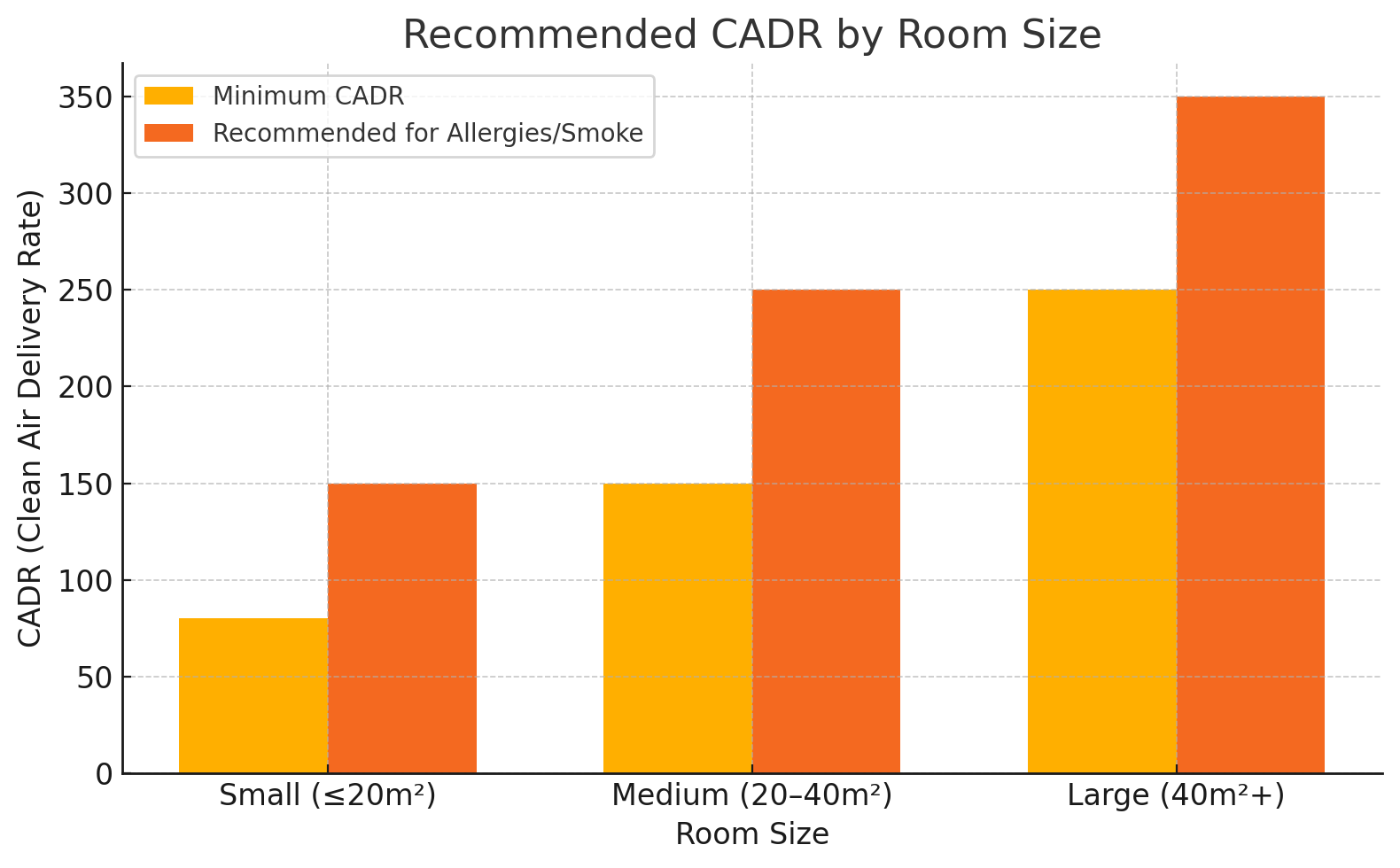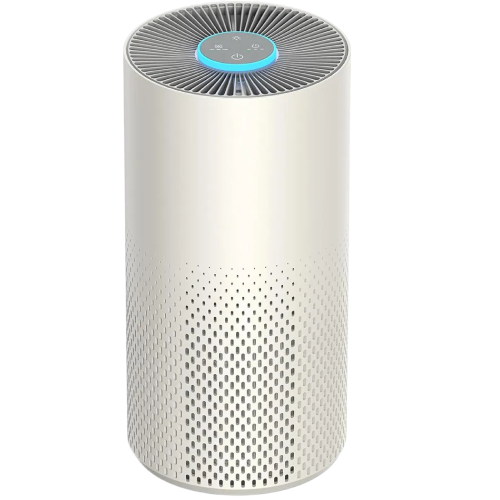If you’re looking to buy an air purifier, chances are you have come across the word HEPA. HEPA (High-Efficiency Particulate Air) air purifiers use filters to remove as much as 99.97% of airborne particles, including dust, pollen, mould, bacteria, and pet dander. They are specifically good for preventing asthma allergies and help with sleep. However, while HEPA filters are excellent for physical particles, they don’t remove gases or odours.
This guide covers everything you need to know about HEPA air purifiers – from essential features to the best types for different needs – so you can confidently choose the right HEPA air purifier for your home.
Additional Filters
While for some of us a HEPA filter might be all that’s needed, a lot of air purifiers come with additional filters to help with other issues, such as smoke and odours. If you need an all-rounder air purifier, look for a hybrid model with multiple filters.
- Pre-filter: Captures large particles, such as hair and lint, to protect the main filters and extend their lifespan.
- HEPA filter: Traps up to 99.97% of microscopic particles as small as 0.3 microns, including smoke, dust, and pollen.
- Activated carbon filter: Absorbs smoke odours, VOCs (volatile organic compounds), and other chemical pollutants.
- HEPA + Carbon combination: The most effective setup for smoke, offering both particle capture and odour removal.
- Ion filter (optional): Releases negatively charged ions that bind to airborne particles, helping them fall out of the air – though not essential for smoke removal.
- Ozone filter: Not typically recommended for indoor use due to potential respiratory irritation.
Room Size Performance
The performance of an air purifier is commonly rated using CADR (Clean Air Delivery Rate), measured in cubic metres per hour (m³/h). This indicates how effectively the purifier can remove smoke, dust, and other macro particles. It’s one of the most important aspects when choosing an air purifier.

Use Case
HEPA air purifiers are versatile and effective across a range of everyday needs. To help you choose the right HEPA air purifier or the correct filter combination for your needs, consider what you’re going to be using your air purifier for. Here are some examples:
- Smoke & Odour Removal – HEPA air purifiers with activated carbon filters trap fine smoke particles and neutralise lingering cooking or cigarette smells.
- Pet Hair & Dander – Capture fur, dander, and allergens, keeping the air cleaner and reducing reactions for sensitive users.
- Babies & Young Children – Create a fresher, healthier environment by filtering out dust, pollen, and airborne pollutants.
- Asthma & Allergies – Relieve symptoms by removing common triggers such as pollen, mould spores, and dust mites.
- Mould Prevention – Help limit the spread of mould spores in damp environments and maintain cleaner indoor air.
- City Pollution – Reduce exposure to fine particulate matter (PM2.5), vehicle emissions, and other urban pollutants.
Air Quality Sensor
Many modern purifiers include a built-in air quality sensor that continuously monitors the air and automatically adjusts fan speed.
- Yes: Automatically senses particle levels and adjusts performance in real time.
- No: Requires manual control, but can still perform effectively with consistent use.
Smart Connectivity (Wi-Fi, App)
Home appliances are getting smarter, and it’s the same for air purifiers. Many are now WI-Fi-compatible, meaning you can control them remotely or from afar via the brand’s app.
Some models even support voice commands via Alexa or other smart assistants for convenient, hands-free operation.
You’re most likely to control these functions via the app:
Typical Modes & Functions
Air purifiers often come with preset modes that suit different needs and lifestyles. Whether you need special functions for use around children and pets or need advanced modes to better adjust to your schedule, look for:
- Auto mode: Adjusts fan speed automatically based on detected and preset air quality.
- Sleep mode: Operates quietly at low speed and often dims all the lights, perfect for nighttime use.
- Child lock: Prevents little hands from changing modes by disabling the touch screen and buttons – ideal for families with children or pets.
- Fan-Only Mode: The appliance runs as a regular fan without activating filtering components (not always included, varies by model).
- Eco / Energy-Saving Mode: Reduces power consumption by lowering fan speed when the air quality is already balanced.
Filter Lifecycle
Filters require regular cleaning or replacement to keep your air purifier working effectively. Always check which types of filters your model uses and how frequently they need replacing to prevent performance loss or unexpected costs.
- Replaceable filters: Most HEPA and carbon filters need replacement every 6–12 months, depending on frequency of use.
- Washable filters: Some models include washable pre-filters or permanent HEPA layers.
- Both: Premium units may feature washable pre-filters combined with replaceable HEPA or carbon filters.
Noise Level (dB)
Noise level is an important consideration, especially if you plan to use your air purifier overnight, in a nursery, or while working. Most models operate quietly, but sound levels can vary between units and often, quieter operation comes at a higher price.
Energy Consumption
With rising energy bills, our appliances’ energy consumption is more important than ever. Whether you’re planning to run your ait purifier often or not, it’s good to check the unit’s consumption beforehand. Compare multiple products and use calculators to get an idea of how much you’re going to spend on electricity, and look for eco modes or eco products.
Look for Energy Star-certified models for the best efficiency.
Maintenance Type
Air purifiers, and especially those with HEPA filters need regular maintenance to ensure efficiency and longevity. Over time, filters and internal components become saturated with dust and can lead to worsened airflow and declined efficiency. Therefore, check your air purifier’s maintenance instructions before purchase.
- No filters to replace: Some models use electrostatic plates to collect particles, reducing running costs.
- Wipe-clean collector plate: A reusable option that needs regular cleaning rather than replacement.
- Filter replacement: Most HEPA and carbon filters need changing every 6–12 months, depending on usage and air quality. Regular replacement ensures optimal performance and prevents trapped pollutants from being released back into the air.
Portability
If you need to move your purifier between rooms or take it with you when travelling or visiting relatives, consider its portability features:
- Wheels: Best for large or heavy models.
- Handles: Useful for compact units and easy repositioning.
Design, Size, and Colours
Air purifiers are available in a range of materials and finishes – from plastic and metal to glass – allowing them to suit any interior. Most come in neutral shades like white, grey, or black, with some models offering metallic or pastel options.
Light Indicators
Light indicators make it easy to track air quality and filter status at a glance. The most common light options include:
- LED ring: Displays air quality via colour codes (e.g., green = clean, red = polluted).
- Digital display: Shows PM2.5 readings, modes, and timer settings.
- LED indicator only: Simple lights showing power or filter alerts.
- None: Basic models with manual control only.
Certifications
Look for independent certifications to confirm your air purifier meets safety, performance, and environmental standards, and consider any awards from trusted publications or industry bodies.
- AHAM: Verifies CADR and room coverage.
- CADR rating: Indicates cleaning speed and capacity.
- Energy Star: Confirms energy efficiency.
- Quiet Mark: Recognises low-noise operation.
Leading Manufacturers Overview
Dyson
Best for: Premium Design | Smart Features | Large Spaces
Dyson’s range of HEPA air purifiers blends innovation with sleek design. Each purifier is fully sealed to the HEPA H13 standard, ensuring no air bypasses the filter. Patented Air Multiplier™ technology projects purified air evenly across large rooms, while models like the Dyson Purifier Cool and Hot+Cool Formaldehyde use a solid-state catalytic filter to break down formaldehyde continuously — a unique advantage in the market.
Cons: High price point; replacement filters can be costly.
Blueair
Best for: Quiet Operation | Design-Led Homes | Mid-to-Large Rooms
Swedish brand Blueair is known for its patented HEPASilent™ technology, which combines mechanical and electrostatic filtration to achieve high particle removal with minimal noise. Their purifiers are ENERGY STAR certified and have strong CADR performance across models. The Blue Pure and HealthProtect lines are especially popular for their minimalist design and whisper-quiet operation, ideal for bedrooms or open-plan living spaces.
Cons: Filter replacements can be expensive, and not all models use True HEPA certification.
Levoit
Best for: Budget-Friendly | Compact Rooms | Easy Operation
Levoit offers affordable yet capable HEPA air purifiers designed for smaller homes and apartments. Its Core Series (including the Core 300 and Core 400S) delivers True HEPA + Activated Carbon filtration, effectively tackling allergens, pet dander, and smoke. Some models feature VeSync app connectivity and voice assistant support, making them smart-ready without the premium price tag.
Cons: Smaller coverage area; some models lack built-in air quality sensors.
Shark
Best for: Low Maintenance | Allergy & Pet Owners | Reliable Everyday Use
Shark’s growing line of HEPA air purifiers focuses on long-term efficiency and user convenience. The brand’s NeverChange5™ filter system lasts up to five years — far longer than typical HEPA filters — reducing maintenance costs. The brand has also patented its Shark’s CleanSense IQ™ sensors that automatically adjust fan speed based on pollution levels. Their models balance practicality, filtration power, and value for money.
Cons: Limited premium smart features; design is more functional than decorative.





